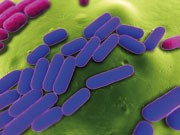Play all audios:
Access through your institution Buy or subscribe Researchers retrospectively assessed the occurrence of recurrent UTI (rUTI) using patient interviews and also investigated the expression of
genes encoding PSA and whey-acid motif 4-disulphide core (WFDC) proteins WFDC2 and SLPI in prostate cell lines. The exact role of WFDC proteins remains unclear, though roles in innate
immunity have been identified. 25 men were included in the final analysis, nine of whom had rUTI. Interestingly, men who had rUTI had a median serum PSA level of 2.4 ng/ml at their initial
episode, compared with 6.3 ng/ml in those who had only a single UTI. This is a preview of subscription content, access via your institution ACCESS OPTIONS Access through your institution
Subscribe to this journal Receive 12 print issues and online access $209.00 per year only $17.42 per issue Learn more Buy this article * Purchase on SpringerLink * Instant access to full
article PDF Buy now Prices may be subject to local taxes which are calculated during checkout ADDITIONAL ACCESS OPTIONS: * Log in * Learn about institutional subscriptions * Read our FAQs *
Contact customer support ORIGINAL RESEARCH PAPER * Townes, C. L. _ et al_. Prostate specific antigen enhances the innate defence of prostatic epithelium against _Escherichia coli_ infection.
_Prostate_ doi:10.1002/pros.22700 Download references Authors * Annette Fenner View author publications You can also search for this author inPubMed Google Scholar RIGHTS AND PERMISSIONS
Reprints and permissions ABOUT THIS ARTICLE CITE THIS ARTICLE Fenner, A. Potential protective role of raised PSA in recurrent UTI. _Nat Rev Urol_ 10, 495 (2013).
https://doi.org/10.1038/nrurol.2013.160 Download citation * Published: 23 July 2013 * Issue Date: September 2013 * DOI: https://doi.org/10.1038/nrurol.2013.160 SHARE THIS ARTICLE Anyone you
share the following link with will be able to read this content: Get shareable link Sorry, a shareable link is not currently available for this article. Copy to clipboard Provided by the
Springer Nature SharedIt content-sharing initiative

